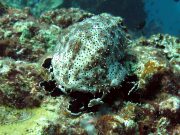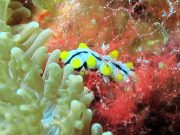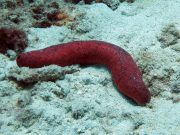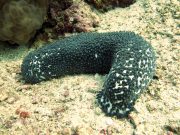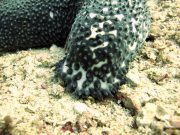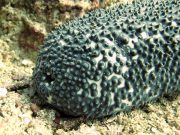The Holothuriidae family of approximately 185 sea cucumbers, several of which we can find in abundance when diving from Koh Lanta.
Holothuriidae sea cucumbers have thick fleshy bodies, ranging from small to very large, often covered with small rounded projections known as papillae. All species have many tube-like feet on the lower body and several species have 15 - 30 oral tentacles.
When stressed or attacked, many members of this family are able to eject many fine sticky white threads from their anus, known as Cuvierian Tubules. These tubes can entangle and disable a predator. The tubes can be internally detached and then re-grown within 2 - 4 weeks.
Depending on the species, sea cucumbers may be concealed below rocks and rubble, buried in sand, found Iying exposed, or in some cases actively moving around a coral reef with their rows of sticky tube feet. A few species are active during the day, however most are active at night.
3 species found on this page.
Graeffe's Sea Cucumber
(Pearsonothuria graeffei)
The Graeffe's Sea Cucumber is one of the most common sea cucumbers encountered at the dive sites around Koh Lanta. This species of sea cucumber has a white body, with many light, thorny projections surrounded by pale brown blotches. There are many small dark spots all over the body and hundreds of small tube feet on the lower body.
Adult Pearsonothuria graeffei @ Koh Haa
Around the mouth are around 20 - 24 tentacles comprising black stalks with leaf-like ends. The leaves are black on the top and white on the bottom and help to ‘feel’ the way around the coral reef.
This species grows up to 30 cm, are very light-weight and are very thin-walled and ‘floppy’ if picked up (we have rescued some from a fishing trap, but do not recommend touching any marine life in the course of a normal dive).
Older Juvenile Graeffe's Sea Cucumber @ Koh Haa
Young Juvenile Graeffe's Sea Cucumber @ Koh Haa
Small juvenile Graeffe's Sea Cucumbers mimic the phyllidiid sea slug Phyllidia varicosa for protection (many nudibranchs are poisonous and distasteful to predators), and as they grow larger than the nudibranch they are impersonating, they start to take on the adult sea cucumber colouration and form. (see photos)
Pinkfish Sea Cucumber
(Holothuria edulis)
Holothuria edulis @ Koh Rok
The Pinkfish Sea Cucumber has a reddish-pink cylindrical body with rounded ends. There is sometimes a black area on the back/upper body, however this species can also be other colours, such as grey or dark brown.
The lower body has rows of small tube feet which help with movement, and which can be retracted into the body if necessary.
There are around 20 oral tentacles which can help with feeding, movement and also righting itself if it is overturned.
The Pinkfish Sea Cucumber grows to 35 cm and is found over sand and rubble is shallow areas of coral reefs.
Blue Sea Cucumber
(Actinopyga caerulea)
The Blue Sea Cucumber has a loaf-shaped body with some tapering toward each end. The body colour is mostly bluish, with white patches. The bluish areas are covered with small conical 'papillae', which are absent in the white areas.
Actinopyga caerulea @ Koh Haa
The mouth of a Blue Sea Cucumber is on the bottom, surrounded by 15 to 18 large bluish-grey tentacles, which in turn are surrounded by a collar of bluish papillae.
The anus of the Blue Sea Cucumber is at the rear end, surrounded by 5 white anal teeth.
Actinopyga caerulea @ Koh Haa
Unlike many other members of the family Holothuriidae, the Cuvierian organ is absent in Blue Sea Cucumbers and this species is unable to eject Cuvieran tubules if stressed.
Actinopyga caerulea @ Koh Haa

